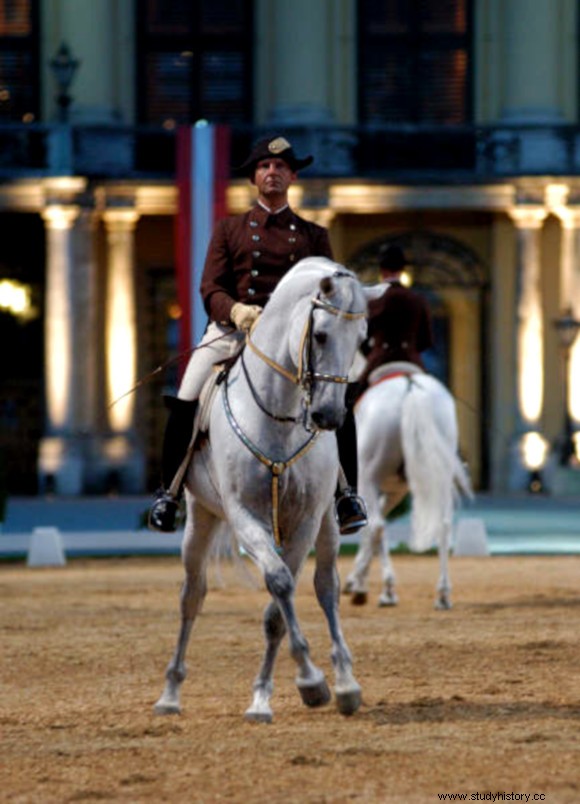One of the most appreciated equine breeds in the world is the lipizana . Originally from the region of Lipizza (Slovenia) as an evolution of an autochthonous horse with other racial mixtures (fundamentally Spanish, but also Arab, Neapolitan and Kladruber), it was from the 16th century when it reached its formidable appearance, thanks to breeding driven by Archduke Charles II of Austria. Since then, the Lipizzan horse It is the base of the prestigiousVienna Spanish Riding School and was chosen by the Slovenian government to lend its image to the new national 20 euro cent coin when the country adopted that currency in 2007.

Now, that race owes part of its success and even its current survival to someone so, a priori , extemporaneous as George Smith Patton . Yes, the American military. And it is that Patton, famous for his role in World War II, in which he first participated in the North African campaign and in Sicily (rivaling almost as much with the Germans as with Montgomery) to later lead dizzying advances on the continent and liberate the 101st Airborne Division in Bastogne, among other merits; Patton, I say, also became the improvised savior of Lipizzaner horses.
After all, he was a cavalry officer and he had participated as a rider in the Olympic Games of Stockholm 1912 , in the Modern Pentathlon category (pistol shooting, fencing, swimming, cross-country running and show jumping). He was also part of the 13th Cavalry when this regiment entered Mexico in pursuit of Pancho Villa; It was Patton precisely who killed Captain Julio Cárdenas, one of the aides of the Mexican revolutionary.
But the subject of this article is set in early 1945, when World War II is in its final stage. Vienna was being subjected to intense bombing and the then director of the aforementioned Spanish Riding School, Colonel Alois Podjahsky , seeing the Lipizzan stallions in danger due to the raids aerial as by the hunger of the population, he decided to transfer them by train about two hundred kilometers, to St. Martins. Taking the valuable Lipizzaners from one place to another due to the war was not new, since it had already happened several times along the history; the last one, at the beginning of the 19th century, during the Napoleonic wars.

Shortly thereafter, that spring of 1945, a new risk appeared on the horizon. At the end of April, the rapidly advancing Red Army He put that town on the verge of being taken and, with it, the animals. Podjahsky feared that the Soviets would slaughter them for their meat , given the food shortage typical of the situation, so he contacted Patton, whom he had known since the aforementioned Olympics, and asked for his help to save the horses (both appear in the lower photo). He risked his skin on it, since it meant agreeing with the enemy. The American accepted and sent Commander Charles H. Reed to lead the so-called Operation Cowboy .
The Lipizzan stud from the Piber Stud Farm had been moved by the Germans to the Czech town of Hostau , where curiously he received care from allied prisoners in some stables. Skipping reporting to the Soviets (Hostau was behind their lines, isolated), Patton negotiated with the German command the delivery of the equids in exchange for granting him immunity. Whether for this or because the Teutonic front was crumbling at times, the fact is that Hostau surrendered on April 28 and handed over the horses to the Third Army, which had made a quick, "Pattonian" raid. And although two days later there was a slight counterattack by the Waffen SS, Berlin capitulated a week later, putting a definitive end to the conflict.

At that time there were almost four hundred copies in Hostau which, together with those of other breeds, far exceeded a thousand animals transported. However, his odyssey would still continue a little longer. Indeed, when Czechoslovakia remained in the Soviet zone, Moscow claimed its property against the protest of the Czechs. Now, that's what Patton's man was there for. A new and unique equine evacuation was quickly organized that took them away from the Red Army, placing them in Wimsbach, almost on the border of West Germany. Finally, in 1955, Alois Podjahsky, who was the only Austrian officer to retain his postwar rank, saw the Lipizzaners return to Vienna. Only eleven returned to Lipizza, which had been integrated into the now extinct Yugoslavia. of the three hundred that he had. Today some six thousand are distributed around the world.
